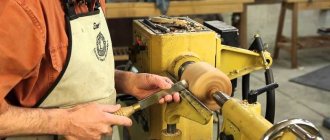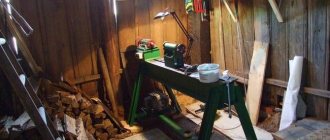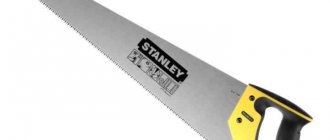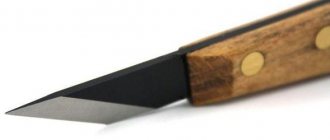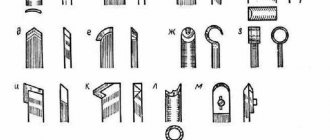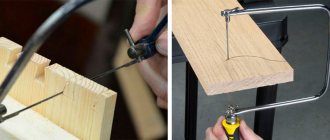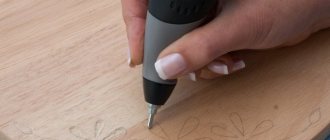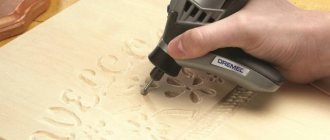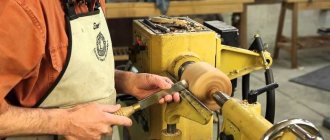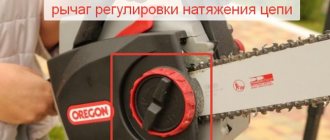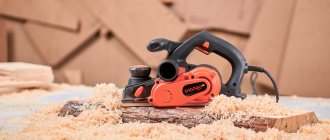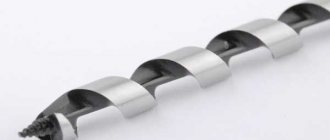Among all the variety of power tools, strict requirements are imposed on grinding machines because... This technique is designed to give the final appearance of the treated surface. There are many types of devices designed for grinding and polishing: angular, belt, vibrating, brush, etc. Each of them is created for specific purposes. Accordingly, their processing quality is different.
What is an eccentric sander?
The essence of this type of technology lies in the complex trajectory of movement of the grinding material installed on the working sole (aka “plate”). The basis of this device is an eccentric mechanism, thanks to which the working surface, in addition to constant rotation, carries out reciprocating movements, which together make it possible to achieve an “orbital” trajectory of the working part.
The size of the installed eccentric directly determines the amplitude of vibration of the sole, which in turn affects the performance of the device. The larger the scope of the translational movement, the rougher the processing and vice versa. The market offers models with a variable eccentric function, which allows you to select several modes - from coarser grinding to the finest polishing.
Which eccentric sander is better?
The additional handle greatly simplifies the use of the electric machine.
It is impossible to answer this question unequivocally, since there are a huge number of different models. However, you can determine a good multi-tool by the number of additional features it offers. A good grinder should be equipped with various accessories and functions;
- possibility of limiting starting current;
- adapter for connecting a vacuum cleaner during auto-grinding;
- power regulator;
- additional handle.
There are situations when people are faced with the need to purchase an ESM. Before you do this, you need to familiarize yourself with what an eccentric wood sander is, which model to choose for home use, and what factors to pay attention to when purchasing a tool.
What kind of work is the ESM intended for?
An eccentric grinder, popularly called an orbital grinder, is used for the most precise fitting of a part (for example, for further opening with varnish, or polishing an already painted surface). In automobile paint shops, the “orbital” is an integral attribute; it is used to identify defects in putty surfaces that are invisible to the eye.
This device is also used for matting a car body, bringing the surface of putty or painted areas in transition areas to an ideal level. And of course, an ESM is an indispensable tool when polishing an already painted body.
Large service stations often use pneumatically driven grinding machines, but for home use, the best option would be a device powered by electrical energy. This technique is also used for processing wood and plastic. So, if the grinder removes a thicker layer of the workpiece and is used mainly when leveling marks from sawing machines, then the eccentric one provides the most precise grinding, as a result of which a perfectly smooth surface is obtained, ready for coating with varnish or stain.
How to choose an eccentric sander
Some people think that choosing an EShM is quite simple. However, this is far from being the case. To purchase a good and inexpensive tool, it is not enough to simply study the rating of eccentric grinders. You also need to familiarize yourself with the parameters that you need to pay attention to when choosing.
Power
When purchasing an EShM for your home, you need to consider the power of the device. To choose the best option, you need to decide on the scope of use of the tool. For example, for home use you should not buy overly powerful models. The most suitable choice would be a device with a power of about 300-400 W.
If you need to frequently sand hard and rough surfaces, you will have to look for a more powerful model. ESMs that will produce from 700-800 W are ideal.
Frequency and amplitude of oscillations
This is one of the most important indicators that must be taken into account when choosing a new grinder. The fact is that the productivity of the device and the quality of surface treatment depend on the frequency and amplitude of vibrations.
For fine grinding, models with a minimum amplitude of about 2-3 mm are suitable. If you need to do rough grinding, then you will have to look for a power tool with higher performance.
Platform diameter
Picture 2 The diameter of the working platform determines which attachments can be used for grinding
All grinders are equipped with special platforms with which attachments for surface treatment are attached. The top eccentric grinders include models with a plate diameter of 125-150 mm. This is the optimal size, suitable for working with metal surfaces and wood.
Additional Information! There are models on sale whose diameter is not so large. They are used for fine grinding of small products.
terms of Use
When choosing a grinding machine, it is necessary to take into account its operating conditions. For example, if it will rarely be used at home for wood processing, there is no need to buy too expensive ESMs. Any budget model is suitable for this.
If this device is purchased for everyday use and processing of hard surfaces, you will have to familiarize yourself with the rating of the most powerful eccentric sanders. Budget models are not suitable for such tasks.
Ergonomics
It is recommended to purchase ergonomic and mobile models that can be used away from outlets. They are equipped with special batteries that allow you to use ESM anywhere, regardless of whether they are connected to a power source.
The ergonomics of the tool are also affected by its dimensions. You should not buy sanders that are too large, as they are not very convenient to use. It is recommended to buy compact models. They fit well in the hands and are more comfortable to work with.
What to look for when choosing an ESM
Despite its seemingly uncomplicated design and functionality, this type of equipment has some nuances, on which the quality and convenience of performing this or that work will depend in the future. Like any other tool, “orbitals” are divided into professional and non-professional.
The main difference lies in the service life of the equipment (and of course the price); if an ordinary household grinding machine is designed for an operating mode of about 20 hours per month, then for “professionals” this figure is several times higher. The following are the main indicators of orbital sanders:
- Power . The most common models are with power consumption from 200 to 600 W, there are also 900 W models, but this is quite rare, and in most cases, such power is not required. This indicator affects the productivity of the machine, but it is worth noting this pattern - the higher the productivity, the lower the quality of the output.
- RPM , electronic speed control. The number of revolutions of the sole reaches 14,000 per minute; if there is a rotation speed regulator, this range is from 2000 to 14,000 rpm; in models without an adjustment function, the average figure is within 12,000. A useful option is electronic stabilization of the rotation speed of the plate, because . this function will keep the speed at a given level regardless of changes in the pressing force of the machine to the object being processed.
- Amplitude of eccentric operation . The most important point among the technical characteristics is the eccentric stroke. The range of reciprocating movements of the working plate depends on this indicator. This parameter ranges from 2-6 mm and the smaller it is, the more accurate processing the device will provide. Some models have a function for adjusting this indicator.
- EShM mass . According to the weight category, these devices are divided into two groups: pneumatic - their weight ranges from 600 grams to 1 kilogram and models with an electric drive, whose weight is slightly higher due to the presence of an electric motor, they weigh on average from 1.1 kg to 4 kg. This indicator should be taken into account in cases where the weight of the tool acts on the operator’s hand (for example, when processing walls or ceilings).
- Network cable length . This indicator does not affect the quality, but it is more convenient and safer to use a tool with a longer power cord so that the extension socket with the plug included in it does not hang in the air during operation.
- Disc diameter . The standard sizes for this parameter are 125 mm and 150 mm; there are also models on the market with a working plane of 80-115 mm, but they are rare. Small diameters are useful when working with workpieces that have a lot of irregularities. The larger the diameter of the plate, the greater the productivity of the device; the large size of the working surface is usually characteristic of devices with higher power, but again, do not forget about the quality, for example, for polishing a car, a powerful machine with high productivity and sole diameter will be inferior in efficiency to a smaller “colleague”.
- Methods for attaching sanding sheets . The abrasive wheel is attached to the sole of the ESM using the so-called “Velcro”; the consumable material is changed instantly - with one movement of the hand. Some manufacturers offer several types of interchangeable soles of different hardness for processing objects with different structures and properties.
- Dust removal system . When an orbital sander operates, a certain amount of fine dust is generated; to collect it, special dust collectors are used, which are filled automatically, thanks to the dust exhaust channels of the device. There are several types of dust collection containers: paper, plastic and fabric. The type of dust collector does not affect the quality and performance in any way, the only question is the ease of cleaning them. Some types of machines are equipped with a function for connecting a vacuum cleaner; special adapters may be included in the kit for these purposes.
In addition to the above basic set of functions, ESMs may have additional ones, depending on the class:
- vibration reduction system – reduces the transmission of vibration vibrations of the device to the operator’s hands;
- pressure indicator – a convenient option for beginners;
- electronic soft start system – reduces the risk of scratches on the surface being processed when the device is started;
- electrodynamic brake – ensures quick stopping of the sole to avoid injury and damage to the workpiece.
No. 10 - “ZUBR” ZOSHM-450-125
Price: 2288 rubles.
ZOShM-450-125 is an orbital sander of the domestic brand “Zubr”. For its modest price it boasts a power of 450 W and 13,000 rpm. It is convenient to adjust the model to your needs, thanks to the ability to adjust the speed. All dust generated during operation flies directly into the dust collector and does not interfere. The maximum disc diameter is 125 mm. ZOSHM-450-125 is an extremely budget-friendly, but quite powerful option for the money that is being asked for the Zubr. The model is quite heavy and does not have ideal ergonomics, but the Zubr ZOShM-450-125 is reliable and successfully copes with its direct responsibilities. If funds are limited, there is a reason to take a closer look at Zubr.
"ZUBR" ZOSHM-450-125
№5 – RUPES ER03 TE
Price: 16,727 rubles.
The next place in the ranking goes to the Rupes ER03 TE orbital sander. This device boasts a modern design, a solid power of 450 W and the ability to adjust the speed in the range from 5000 to 10000 per minute. The maximum disc diameter is 150 mm. There is a dust collector. Reliability and long service life are ensured by the engine ventilation system. Rupes ER03 TE is a grinder with good technical performance, an ergonomic handle and relatively light weight, which makes it quite convenient. Value for money is another reason to seriously consider purchasing the Rupes ER03 TE.
RUPES ER03 TE
